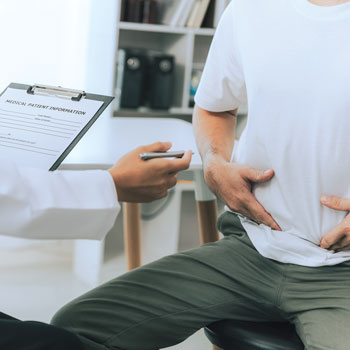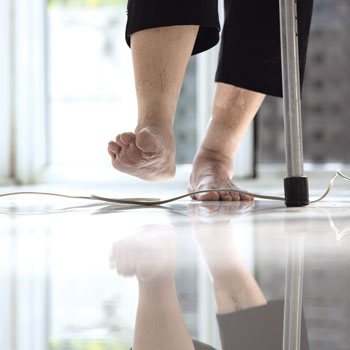Addressing abdominal pain's many causes
A session at ACG 2024 covered diagnoses similar to IBS that clinicians should keep on their differential and outlined the role of neuromodulators in treating disorders of the gut-brain interaction.
Primary care physicians are no strangers to treating abdominal pain. In a session at the American College of Gastroenterology's 2024 Annual Scientific Meeting, held in Philadelphia in October, experts offered advice on how to address this common symptom, including keeping a broad differential, understanding the role of neuromodulators, and getting familiar with digital therapeutic tools.
To kick off the session, Lavanya Viswanathan, MD, MS, FACP, associate professor of gastroenterology, hepatology, and nutrition at The University of Texas MD Anderson Cancer Center in Houston, laid out conditions that present similarly to irritable bowel syndrome (IBS) and described how to identify and treat them.

“About 15% of Americans report pain and abnormal bowel habits for at least three months, and … the prevalence of IBS in America is 6%,” she said. Given there's no single biomarker for IBS and it can overlap with other conditions, she asked attendees, “How do we tell the difference between who has IBS and who might [have] something else?”
The first alternative diagnosis could be disaccharidase deficiency, a condition where patients often report pain, gas, bloating, and diarrhea. Patients can have a single enzyme deficiency or deficiencies can occur in combination, though patients with pan-disaccharidase deficiency typically present with weight loss. Recent data have shown the condition to be more common in adults than previously thought, Dr. Viswanathan said, adding that the gold standard for diagnosis is endoscopic small-bowel biopsy. The only FDA approved treatment is sacrosidase. Dr. Viswanathan coauthored a review on diagnosis and management of disaccharidase deficiency that was published May 18, 2023, by Current Gastroenterology Reports.
Another possibility is small intestinal bacterial overgrowth (SIBO) and intestinal methanogenic overgrowth (IMO). “This is a clinical syndrome of maldigestion, in which patients present with bloating, pain, constipation or diarrhea, weight loss, and, if severe enough, nutritional deficiencies. It affects over a third of the worldwide population,” Dr. Viswanathan said. Of note, IBS patients are four times more likely to have SIBO, and treatment for the condition can “reduce or even eliminate IBS symptoms,” she said. SIBO is also not a primary disorder, and the gold standard for diagnosis is duodenal aspirate culture, though breath testing is less invasive and a more common testing method. IMO commonly presents with constipation, rather than diarrhea. “The treatment is solo or combination antibiotic therapy. Traditionally, we give rifaximin and neomycin,” Dr. Viswanathan explained.
Cannabinoid hyperemesis syndrome was next on the list. Patients can present with pain, nausea, and recurrent vomiting episodes. “The usual therapy is to try to prevent a flare rather than try to attenuate symptoms,” Dr. Viswanathan said. Because cannabis is legal in some states and not others, “if you're asking your patients if they're using illegal drugs or [about] recreational drug use, you may be missing the boat if they're using cannabis,” she said. She suggested clinicians ask for cannabis by name.
While hot showers can help alleviate some symptoms of cannabinoid hyperemesis syndrome, it only resolves with extended cannabis abstinence. “Traditional antiemetic agents are usually ineffective, and the hard part about dealing with this disease process is convincing your patients that cannabis is the culprit rather than the cure,” Dr. Viswanathan said.
A rare alternative diagnosis to IBS is eosinophilic gastroenteritis. The condition has a prevalence of up to 28 cases per 10,000 in the U.S., though it may be underestimated “due to its overlapping symptoms with other DGBIs [disorders of gut-brain interaction],” said Dr. Viswanathan. There are three forms of the condition, mucosal, muscular, and serosal, with mucosal being the most common. At least half of these patients present with gastrointestinal (GI) symptoms, she said. Lab work is required to make a diagnosis. “Peripheral eosinophilia will be present, typically around 70%,” Dr. Viswanathan said, noting that hypoalbuminemia, iron deficiency, an elevated erythrocyte sedimentation rate, and fecal protein loss are other things to look out for.
The autoimmune condition celiac disease has a strong association with IBS, and its prevalence is much higher in patients with IBS. Dr. Viswanathan cited a review published by BMC Medicine in July 2019, which reported that patients with celiac disease had more than a threefold risk for later diagnosis of IBS and that fewer than one-third of patients with celiac disease present with the classical symptoms of diarrhea, weight loss, and malabsorption.
After physicians consider the wide array of possibilities, “if your IBS patients are not getting better, don't anchor your diagnosis,” Dr. Viswanathan said. “Keep a broad differential.”
Understanding, using neuromodulators
In the next talk, Lin Chang, MD, a gastroenterologist and professor of medicine at University of California, Los Angeles, outlined when and how to use neuromodulators to treat abdominal pain.
She began by highlighting the extent to which opioids have been prescribed to treat GI diseases. Of 351 million ambulatory visits documented by the National Ambulatory Medical Care Survey between 2006 and 2016, research shows that 10% resulted in an opioid prescription.
What's more, chronic pancreatitis, chronic liver disease, and Crohn's disease were the main diagnoses where opioids were used, and “abdominal pain had the highest number of weighted visits with an opioid prescription,” she said. The study was published by the American Journal of Gastroenterology in April 2021.
Once the adverse effects of opioids were recognized and prescriptions began decreasing, Dr. Chang wanted to see what drugs were being prescribed in their place. She and her colleagues used Medicare Part D data to perform a retrospective cross-sectional study of approximately 13,000 gastroenterologists who had prescribed opioids at least once from 2013 to 2017. The research, published by Gastroenterology in February 2020, showed that “anti-spasmodic [prescriptions] started going up, and that's one of the most commonly used class of agents for abdominal pain” she explained. “But when we looked at gut-brain neuromodulators, these prescriptions were pretty steady, so providers were not prescribing neuromodulators, even though they can reduce abdominal pain.”
Many patients with chronic abdominal pain have psychiatric or psychological symptoms that can also be treated with neuromodulators, Dr. Chang said. Central neuromodulators in particular “can have a neurogenesis or neuroplasticity effect, [in] that they'll enhance nerve cell regrowth.”
However, a study she coauthored, published by Alimentary Pharmacology and Therapeutics in June 2021, showed that many clinicians are concerned about the side effects of neuromodulators and limit their use in patients with IBS. Clinicians also aren't sure which neuromodulator they should use and don't feel comfortable or competent prescribing them.
“There's definitely an unmet educational need on how to prescribe neuromodulators, which ones to use, and how to manage them,” she said.
There are four major classes of central neuromodulators, including tricyclic antidepressants (TCAs), selective serotonin reuptake inhibitors (SSRIs), serotonin-norepinephrine reuptake inhibitors (SNRIs), and tetracyclic antidepressants.
TCAs are the first-line treatment for patients with abdominal pain specifically related to DGBI, Dr. Chang said. SSRIs have not been shown to be effective in relieving GI symptoms in these disorders but are the only central neuromodulators that are not constipating. SNRIs are effective agents for pain and have been approved by the FDA for neuropathic pain, fibromyalgia, depression, and anxiety. Last, tetracyclic antidepressants “have been shown to be effective for upper and lower GI tract symptoms including early satiety, dyspepsia, and abdominal pain,” Dr. Chang said. They're also effective for weight loss and can improve sleep, as can TCAs, which have an antihistamine effect. Because poor sleep is very common in patients with IBS and other DGBI, be sure to ask about sleep and try to improve it, she stressed.
For IBS specifically, both the American College of Gastroenterology and the American Gastroenterological Association guidelines recommended using TCAs, though they had different assessments of the strength of recommendation and quality of evidence, Dr. Chang noted.
She recommends using the TCA amitriptyline for patients with IBS and diarrhea, especially if they are having trouble sleeping. “If they don't have diarrhea and they have IBS mixed bowel habits or constipation, you can still use a tricyclic, but you want to use one with less anticholinergic effect, like desipramine or nortriptyline,” she said.
It's important to start patients on a low daily dose of amitriptyline, like 10 or 25 mg, and then increase to the most effective dose the patient can tolerate. Be mindful not to increase the dose by more than 10 mg per week, though, she said. Of note, “a dose of 75 mg or lower is typically not sufficient to exert a mood effect. So do not think that if you give 25 mg of amitriptyline you're reducing anxiety and depression,” she added. “It usually takes about six to eight weeks on an appropriate dose to see if it really can substantially reduce abdominal pain.”
Neuromodulators can be augmented with other neuromodulators or brain-gut behavioral therapy such as cognitive behavioral therapy, but the treatment approach depends on patients' predominant symptoms.
In patients for whom pain is predominant, early initiation of a neuromodulator is key. For patients reporting mostly anxiety or depression, “you really want to refer to psychiatry [and] get that result, and then you collaborate with [psychiatry] on the choice of the neuromodulator that could help their mood symptoms and their abdominal symptoms,” Dr. Chang said. Finally, for patients with anxiety that is mostly related to their GI symptoms, “you probably want to initiate behavioral therapy earlier and add a neuromodulator if symptoms are more severe.”
If patients taking a neuromodulator are doing well and their symptoms are mostly resolved, they should continue the treatment for six to 12 months before tapering. “I tend to do a year,” Dr. Chang said, “because I'm hoping [the medications] have a neuroplasticity effect, and [patients] don't need to continue to take the neuromodulator, and by that time, they've learned to manage their symptoms.”
At-home resources
In the last presentation, Jill K. Deutsch, MD, MA, a gastroenterologist and assistant professor at Yale School of Medicine in New Haven, Conn., walked attendees through the plethora of digital tools available to IBS patients. Specifically, she focused on nutrition and psychology services, complementary and alternative medicine (CAM) resources, and symptom tracking technology.
Several tools can help patients with IBS adhere to nutritional recommendations, including following a low FODMAP (fermentable oligosaccharides, disaccharides, monosaccharides, and polyols) diet. FODMAP foods “increase GI water secretion, which increases, in turn, fermentation in the colon, leading to short-chain fatty acids, increased gas, osmotic bloating, and symptoms,” Dr. Deutsch explained.
Once patients eliminate FODMAPs from their diet, they can slowly reintroduce specific foods to see what triggers symptoms. Maintenance of a low FODMAP diet thus becomes very personalized. Digital health services to assist with this include apps such as the Monash University FODMAP Diet, she said.
Online psychology resources can be helpful for IBS patients too, Dr. Deutsch said. Data show that many patients are good candidates for brain-gut behavioral therapies, including those who are accepting of the diagnosis, those who have insight into the role of stress on their symptoms, and those who are open to learning mind-body techniques and incorporating daily “homework,” she said.
When it comes to CAM, vitamins and supplements are most commonly used for GI disorders, and Dr. Deutsch noted that this industry is not well regulated. However, she said, “we do know that those that at least have a USP seal as a dietary supplement means that they're verified, and so there's perhaps a little bit more of a standardized process there.”
She offered HerbList, an NIH National Center for Complementary and Integrative Health-sponsored app, and the Nat Med website as two resources for reliable information on CAM.
As for symptom trackers like Dieta Health and MyGiHealth, Dr. Deutsch said that clinicians “want [them] to be helpful to us and not to present us with 15 pages worth of data that we're not necessarily sure what to do with when we're in the visit.” She added that it might not be beneficial for a highly anxious patient with IBS to take on the additional task of symptom tracking on their own time, as it could add to their anxiety.
“That unfortunately starts to spin that whole dysregulation of the gut-brain interaction a bit out of control and may be defeating the purpose of why we want to obtain these long-term trajectories over time of symptom management,” she explained.
The many different mechanisms that drive IBS allow practitioners to tailor therapeutics to individual patients. “Unfortunately, there are just not enough experts in this country or in this world available to deliver high quality, nonpharmacologic therapies for IBS, including … those brain-gut behavioral therapies or even nutrition services,” Dr. Deutsch said. Given that, she said, “patient-focused adjunctive resources certainly are helpful to track diseases and deliver the tailored therapeutics for our patients.”



